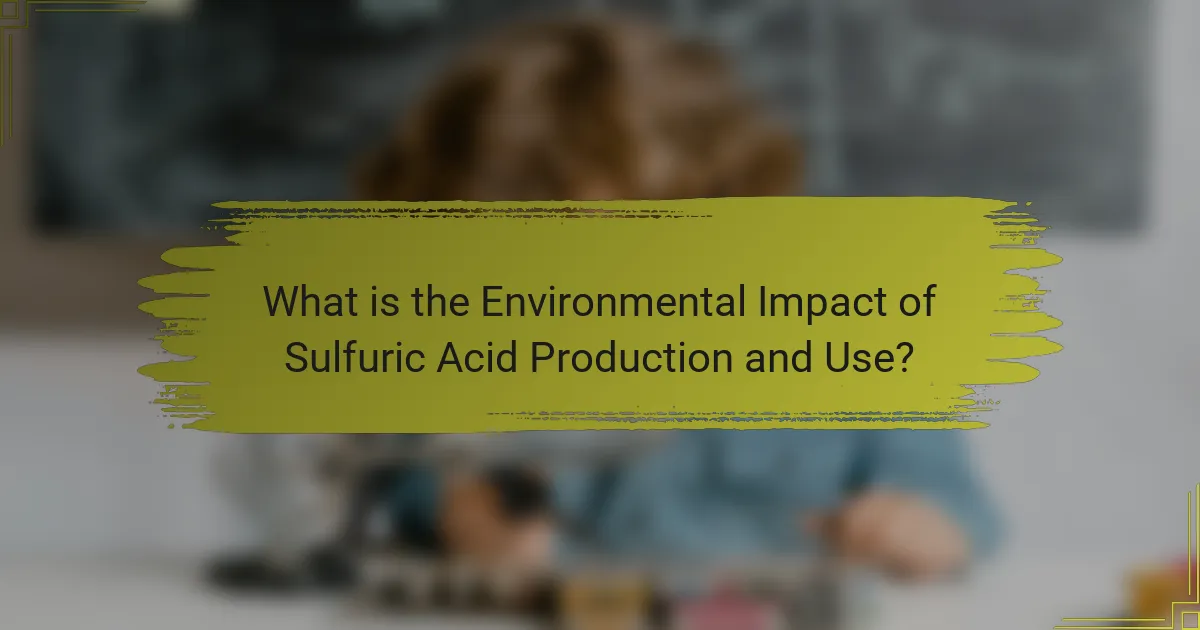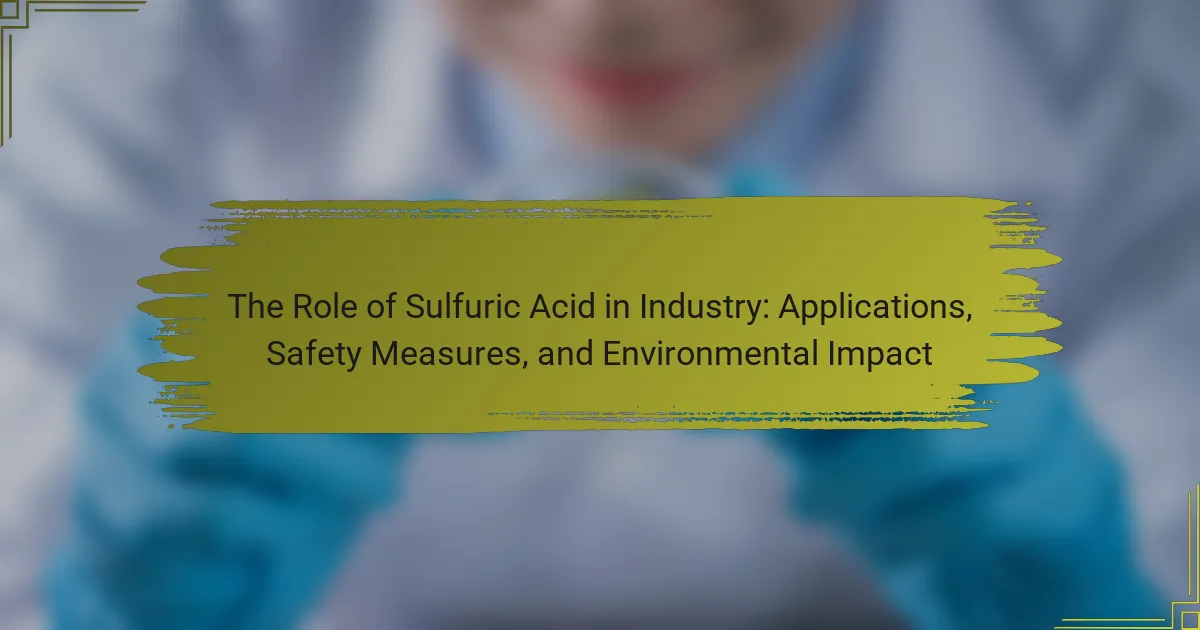
What is Sulfuric Acid and Why is it Important in Industry?
Sulfuric acid is a strong mineral acid with the chemical formula H2SO4. It is crucial in various industrial processes. The acid is primarily used in the production of fertilizers, particularly phosphates. Sulfuric acid also plays a key role in refining petroleum and processing metals. It is involved in the manufacture of chemicals like hydrochloric acid and nitric acid. The acid is significant for lead-acid batteries, which power many vehicles. Additionally, sulfuric acid is essential for wastewater treatment and in the production of explosives. Its versatility and effectiveness make it one of the most widely produced industrial chemicals globally.
How is Sulfuric Acid Produced?
Sulfuric acid is primarily produced through the Contact Process. This method involves the oxidation of sulfur dioxide (SO2) to sulfur trioxide (SO3) using a vanadium pentoxide catalyst. The reaction occurs at high temperatures, typically around 450°C.
The sulfur trioxide is then absorbed in water to form sulfuric acid. This absorption reaction is exothermic and requires careful control to avoid the formation of a mist.
In addition to the Contact Process, sulfuric acid can also be produced via the Lead Chamber Process, which is less common today. This older method involves the reaction of sulfur dioxide with nitric oxide and oxygen.
Overall, the Contact Process is the most efficient and widely used method for sulfuric acid production, accounting for about 90% of global production.
What are the primary methods of sulfuric acid production?
The primary methods of sulfuric acid production are the Contact Process and the Lead Chamber Process. The Contact Process involves the oxidation of sulfur dioxide (SO2) to sulfur trioxide (SO3) using a vanadium pentoxide catalyst. This process operates at high temperatures and pressures to maximize yield. The sulfur trioxide is then absorbed in water to produce sulfuric acid.
The Lead Chamber Process, an older method, uses sulfur dioxide and nitrogen oxides to produce sulfuric acid in large chambers. This method operates at lower temperatures and produces a lower concentration of acid compared to the Contact Process.
Both methods are widely used in industry, with the Contact Process being the most common today due to its efficiency and higher purity of the final product.
What raw materials are required in the production process?
The raw materials required in the production process of sulfuric acid are sulfur, water, and air. Sulfur serves as the primary feedstock. It is often sourced from sulfur mines or produced from sulfur-containing minerals. Water is necessary for the dilution and reaction processes. Air provides the oxygen needed for the oxidation of sulfur dioxide during production. The production method typically involves the Contact Process, which efficiently converts sulfur dioxide to sulfur trioxide. This process has been widely adopted in industrial settings due to its effectiveness and scalability.
What are the Key Applications of Sulfuric Acid in Various Industries?
Sulfuric acid is a vital industrial chemical with key applications across various sectors. It is predominantly used in the production of fertilizers, especially phosphates. Approximately 60% of sulfuric acid produced globally is utilized in fertilizer manufacturing. Additionally, sulfuric acid plays a crucial role in petroleum refining. It is used to remove impurities and enhance fuel quality. The chemical is also essential in the manufacturing of chemicals such as hydrochloric acid and nitric acid. In the metal processing industry, sulfuric acid is used for metal cleaning and pickling. Furthermore, it is involved in battery production, particularly for lead-acid batteries, which are widely used in vehicles. The versatility of sulfuric acid makes it indispensable in many industrial processes.
Which industries utilize sulfuric acid the most?
The industries that utilize sulfuric acid the most include the chemical manufacturing, petroleum refining, and metal processing industries. Chemical manufacturing uses sulfuric acid in the production of fertilizers, particularly phosphoric acid. The petroleum refining industry employs sulfuric acid for alkylation processes to produce high-octane gasoline. Metal processing utilizes sulfuric acid for ore processing and metal cleaning. According to the US Geological Survey, sulfuric acid is one of the most widely produced chemicals globally, with millions of tons consumed annually across these sectors.
How is sulfuric acid used in the manufacturing of fertilizers?
Sulfuric acid is used in the manufacturing of fertilizers primarily to produce phosphoric acid. This process involves reacting sulfuric acid with phosphate rock. The reaction generates phosphoric acid, which is a key ingredient in many fertilizers. Additionally, sulfuric acid helps in the production of ammonium sulfate. This is achieved by reacting sulfuric acid with ammonia. The resulting ammonium sulfate is an important nitrogen source for plants. The use of sulfuric acid in these processes enhances nutrient availability in fertilizers. This application is crucial for improving crop yields globally.
What role does sulfuric acid play in chemical synthesis?
Sulfuric acid is a crucial catalyst in chemical synthesis. It facilitates reactions such as esterification and dehydration. In esterification, sulfuric acid helps produce esters from alcohols and acids. The acid’s strong dehydrating properties promote the removal of water. This enhances the yield of desired products. Additionally, sulfuric acid is used in nitration reactions. It generates nitronium ions, essential for synthesizing nitrated compounds. Its role as a dehydrating agent is vital in producing sulfuric acid derivatives. These derivatives are key in various industrial applications.
What are the Benefits of Using Sulfuric Acid in Industrial Processes?
Sulfuric acid is a highly versatile chemical widely used in industrial processes. It serves as a dehydrating agent, facilitating reactions by removing water. This property is crucial in the production of fertilizers, particularly phosphoric acid.
Additionally, sulfuric acid acts as a strong acid catalyst in various chemical reactions. It enhances the efficiency of processes like esterification and alkylation. The acid’s ability to dissolve metals makes it essential in metal processing and refining.
Sulfuric acid also plays a significant role in battery manufacturing, particularly lead-acid batteries. These batteries are commonly used in vehicles and backup power systems.
Moreover, sulfuric acid is vital in wastewater treatment processes. It helps in neutralizing alkaline substances, ensuring proper pH levels.
Overall, sulfuric acid’s unique properties and applications contribute significantly to industrial efficiency and productivity.
How does sulfuric acid enhance production efficiency?
Sulfuric acid enhances production efficiency by acting as a catalyst in various chemical processes. It accelerates reactions, leading to faster production rates. In the production of fertilizers, sulfuric acid facilitates the conversion of phosphate rock into phosphoric acid. This process is crucial for producing high-quality fertilizers efficiently. Additionally, sulfuric acid is used in petroleum refining to remove impurities. This results in higher yields of valuable products. Its ability to absorb water also aids in dehydration processes, further increasing efficiency. Overall, sulfuric acid’s role in chemical reactions and purification processes significantly boosts industrial productivity.
What economic advantages does sulfuric acid provide to manufacturers?
Sulfuric acid provides significant economic advantages to manufacturers. It is a key component in various industrial processes, including fertilizer production, petroleum refining, and metal processing. Its low cost relative to other industrial chemicals enhances profitability. The versatility of sulfuric acid allows for its use in multiple applications, which reduces the need for diverse chemical inventories. Additionally, it improves process efficiency, leading to lower operational costs. For instance, in fertilizer production, sulfuric acid increases yield and reduces waste. This efficiency translates into higher output for manufacturers. Overall, the economic benefits of sulfuric acid stem from its cost-effectiveness, versatility, and efficiency in industrial applications.

What Safety Measures are Necessary When Handling Sulfuric Acid?
When handling sulfuric acid, essential safety measures include wearing appropriate personal protective equipment (PPE). This PPE should consist of acid-resistant gloves, goggles, and a face shield. Additionally, it is crucial to work in a well-ventilated area to avoid inhaling harmful fumes.
Proper storage is also vital; sulfuric acid must be kept in a corrosion-resistant container. Always have a neutralizing agent, like sodium bicarbonate, readily available for spills. Training in emergency procedures is necessary for all personnel handling sulfuric acid.
These measures are supported by the Occupational Safety and Health Administration (OSHA), which emphasizes the importance of PPE and proper handling techniques to prevent accidents and injuries.
What are the Hazards Associated with Sulfuric Acid?
Sulfuric acid is a highly corrosive substance that poses significant hazards. It can cause severe burns upon contact with skin or eyes. Inhalation of sulfuric acid vapors can lead to respiratory distress and lung damage. Exposure can result in chemical pneumonitis or pulmonary edema. Additionally, sulfuric acid can react violently with water, releasing heat and causing splattering. It is also a strong dehydrating agent, capable of damaging organic materials. Proper handling and safety measures are essential to mitigate these risks. The Occupational Safety and Health Administration (OSHA) classifies sulfuric acid as a hazardous chemical, highlighting its potential dangers in industrial settings.
What health risks are posed by exposure to sulfuric acid?
Exposure to sulfuric acid poses several significant health risks. Inhalation can lead to respiratory issues, including bronchitis and pulmonary edema. Skin contact may cause severe burns and tissue damage. Eye exposure can result in corneal damage and permanent blindness. Ingestion of sulfuric acid is highly toxic and can lead to gastrointestinal perforation. Long-term exposure may cause chronic respiratory diseases and skin sensitization. The Centers for Disease Control and Prevention (CDC) classify sulfuric acid as a corrosive substance, emphasizing the need for proper safety measures when handling it.
How can environmental hazards be mitigated?
Environmental hazards can be mitigated through effective management strategies. Implementing strict regulations on emissions reduces harmful pollutants. Regular monitoring of air and water quality helps identify potential risks early. Utilizing technology, such as scrubbers and filters, minimizes industrial waste. Promoting sustainable practices in industries decreases environmental impact. Educating the public about environmental issues fosters community involvement. Investing in research for cleaner alternatives supports long-term solutions. Collaborative efforts between governments and organizations enhance overall effectiveness in hazard mitigation.
What Personal Protective Equipment (PPE) is Recommended for Working with Sulfuric Acid?
The recommended Personal Protective Equipment (PPE) for working with sulfuric acid includes chemical-resistant gloves, goggles, and face shields. Chemical-resistant gloves protect the skin from direct contact with the acid. Goggles provide eye protection against splashes. Face shields offer additional protection for the face and neck. Additionally, a lab coat or chemical-resistant apron is advisable to protect clothing and skin. Proper ventilation is also essential in the workspace. These recommendations align with safety guidelines from organizations such as the Occupational Safety and Health Administration (OSHA).
What types of gloves and clothing should be worn?
Chemical-resistant gloves and protective clothing should be worn when handling sulfuric acid. These gloves are typically made from materials such as neoprene, nitrile, or butyl rubber. Long-sleeved lab coats or coveralls made of chemical-resistant fabric are also essential. Eye protection, such as goggles or face shields, should accompany gloves and clothing. This combination prevents skin and eye exposure to sulfuric acid. According to OSHA guidelines, appropriate personal protective equipment is crucial in minimizing chemical exposure risks.
How important is respiratory protection when handling sulfuric acid?
Respiratory protection is crucial when handling sulfuric acid. Sulfuric acid can release harmful vapors that may cause respiratory irritation or damage. Exposure to these vapors can lead to serious health issues, including lung damage and chemical burns. The American Conference of Governmental and Industrial Hygienists (ACGIH) recommends using appropriate respiratory protection to mitigate these risks. Proper respiratory gear can significantly reduce the likelihood of inhaling harmful substances. Therefore, using respiratory protection is essential for safety when working with sulfuric acid.
What Emergency Procedures Should be Followed in Case of Sulfuric Acid Spills?
In case of sulfuric acid spills, immediate containment is essential. First, evacuate all personnel from the area. Next, assess the spill size and determine the appropriate response. Use absorbent materials like sand or specialized spill kits to contain the acid. Ensure proper personal protective equipment is worn, including gloves and goggles. Neutralize the acid with a suitable base, if safe to do so. Dispose of the neutralized material according to local regulations. Report the spill to the relevant authorities for further assistance. Following these procedures minimizes risks and ensures safety in industrial settings.
How can spills be contained and neutralized effectively?
Spills can be contained and neutralized effectively using absorbent materials and neutralizing agents. Absorbent materials, such as sand or commercial spill kits, quickly soak up the liquid. This prevents further spread of the hazardous substance. Neutralizing agents, like sodium bicarbonate, can be applied to sulfuric acid spills. Sodium bicarbonate reacts with sulfuric acid to produce carbon dioxide and water, making the spill safer to handle. After neutralization, the solidified residue can be safely disposed of according to local regulations. Proper training and safety equipment are essential for personnel managing spills. These methods are supported by safety guidelines from organizations such as OSHA and EPA.
What first aid measures should be taken for sulfuric acid exposure?
Immediately flush the affected area with plenty of water for at least 15 minutes. This dilutes the sulfuric acid and helps reduce damage. Remove contaminated clothing while rinsing to prevent further skin exposure. If the acid comes into contact with the eyes, rinse them with water for at least 15 minutes and seek medical attention immediately. For inhalation exposure, move the person to fresh air and monitor for breathing difficulties. Always seek professional medical help after initial first aid measures. These steps are crucial to minimize injury and complications from sulfuric acid exposure.

What is the Environmental Impact of Sulfuric Acid Production and Use?
The environmental impact of sulfuric acid production and use is significant. Sulfuric acid is primarily produced through the contact process, which generates sulfur dioxide (SO2) emissions. These emissions can contribute to air pollution and acid rain formation. Acid rain can harm ecosystems, damage water sources, and affect soil quality.
Additionally, sulfuric acid can cause soil and water acidification when improperly disposed of or leaked. This can lead to detrimental effects on aquatic life and plant growth. The production process also requires large amounts of energy, contributing to greenhouse gas emissions.
According to the U.S. Environmental Protection Agency, sulfur dioxide is a key pollutant that can lead to respiratory problems in humans. The production and use of sulfuric acid must be managed carefully to mitigate these environmental impacts.
How does Sulfuric Acid Affect Air and Water Quality?
Sulfuric acid negatively affects air and water quality. In the air, it contributes to the formation of acid rain. This occurs when sulfur dioxide, released during combustion processes, reacts with atmospheric moisture. Acid rain can harm ecosystems, damage vegetation, and lead to soil degradation.
In water, sulfuric acid can lower pH levels, making water bodies more acidic. This acidity can harm aquatic life, disrupting ecosystems and affecting species survival. High concentrations of sulfuric acid can also lead to metal leaching from soils and sediments.
According to the United States Environmental Protection Agency, sulfuric acid is a significant contributor to acid rain, impacting both air and water quality.
What pollutants are released during sulfuric acid production?
Sulfuric acid production releases several pollutants. The primary pollutants include sulfur dioxide (SO2), nitrogen oxides (NOx), and particulate matter. Sulfur dioxide is generated from the combustion of sulfur-containing materials. Nitrogen oxides are produced during high-temperature reactions in the presence of nitrogen. Particulate matter may arise from the raw materials and combustion processes. These pollutants can contribute to air quality issues and acid rain. Regulatory measures often aim to control these emissions during production.
How can sulfuric acid contamination in water bodies be addressed?
Sulfuric acid contamination in water bodies can be addressed through neutralization, containment, and treatment methods. Neutralization involves adding alkaline substances, such as lime, to raise the pH of the contaminated water. This process converts sulfuric acid into less harmful compounds. Containment strategies include constructing barriers or dikes to prevent further spread of contamination. Treatment methods, such as reverse osmosis or ion exchange, can effectively remove sulfuric acid from water. Monitoring and regular testing of water quality are essential to evaluate the effectiveness of these interventions. These approaches are supported by environmental regulations aimed at reducing acid runoff and protecting aquatic ecosystems.
What Regulatory Measures Exist to Control Sulfuric Acid’s Environmental Impact?
Regulatory measures to control sulfuric acid’s environmental impact include the Clean Air Act and the Resource Conservation and Recovery Act. The Clean Air Act regulates sulfur dioxide emissions, which can arise from sulfuric acid production. Compliance with National Ambient Air Quality Standards is required to minimize air pollution. The Resource Conservation and Recovery Act governs the management of hazardous waste, including sulfuric acid. Facilities must follow specific guidelines for storage, disposal, and treatment of this chemical. Additionally, the Environmental Protection Agency monitors and enforces these regulations to ensure compliance. State regulations may also impose stricter standards depending on local environmental conditions. These measures collectively aim to mitigate sulfuric acid’s adverse effects on the environment.
What are the key regulations governing sulfuric acid use?
Key regulations governing sulfuric acid use include the Occupational Safety and Health Administration (OSHA) standards and the Environmental Protection Agency (EPA) regulations. OSHA sets permissible exposure limits for sulfuric acid in the workplace. This limit is 1 mg/m³ as an 8-hour time-weighted average. The EPA regulates sulfuric acid under the Clean Air Act and the Resource Conservation and Recovery Act (RCRA). The RCRA classifies sulfuric acid as a hazardous waste if it exhibits certain characteristics. Additionally, manufacturers must comply with the Toxic Substances Control Act (TSCA), which requires reporting and recordkeeping for sulfuric acid production and use. These regulations ensure safe handling, storage, and disposal of sulfuric acid to protect human health and the environment.
How can industries comply with environmental standards related to sulfuric acid?
Industries can comply with environmental standards related to sulfuric acid by implementing strict waste management protocols. These protocols should include proper storage and handling procedures to prevent leaks and spills. Regular monitoring of sulfuric acid emissions is essential to ensure compliance with air quality standards. Industries should also invest in scrubbers and neutralization systems to treat waste gases and effluents. Training employees on safe handling practices is crucial for minimizing risks. Additionally, adhering to regulations set by environmental agencies, such as the Environmental Protection Agency (EPA), is necessary for compliance. These measures collectively help mitigate the environmental impact of sulfuric acid usage in industrial processes.
What Best Practices Should Industries Follow to Minimize Environmental Risks?
Industries should adopt best practices such as waste reduction, resource efficiency, and pollution prevention to minimize environmental risks. Implementing a circular economy approach can significantly reduce waste generation. Regular environmental audits help identify areas for improvement. Training employees on sustainability practices enhances compliance and awareness. Utilizing cleaner production techniques lowers emissions and resource consumption. Collaborating with stakeholders fosters innovation in sustainable practices. Adhering to environmental regulations ensures legal compliance and reduces liabilities. Finally, investing in green technologies can lead to long-term cost savings and environmental benefits.
How can waste management practices reduce sulfuric acid’s footprint?
Waste management practices can significantly reduce sulfuric acid’s footprint by minimizing its release into the environment. Effective waste management includes proper disposal and treatment of sulfuric acid waste. This prevents acid from contaminating soil and water sources. Recycling processes can also reclaim sulfuric acid from industrial waste. This reduces the need for new acid production, lowering overall emissions. According to the Environmental Protection Agency, proper waste management can decrease hazardous waste generation by up to 50%. Implementing these practices contributes to a more sustainable industrial process.
What alternatives to sulfuric acid can be considered in industrial applications?
Alternatives to sulfuric acid in industrial applications include hydrochloric acid, nitric acid, and phosphoric acid. Hydrochloric acid is commonly used for metal cleaning and pickling. Nitric acid serves as an oxidizing agent in various chemical processes. Phosphoric acid is often utilized in fertilizers and food processing. Each alternative has specific applications based on its chemical properties. For example, hydrochloric acid effectively removes rust and scale from metals. Nitric acid is crucial in producing explosives and fertilizers. Phosphoric acid is essential in the production of phosphate-based fertilizers. These alternatives can provide similar functionalities while potentially reducing environmental impact.
Sulfuric acid (H2SO4) is a crucial industrial chemical widely used in the production of fertilizers, petroleum refining, and metal processing. This article explores its production methods, primarily the Contact Process, and highlights its key applications across various industries. It also addresses safety measures necessary for handling sulfuric acid, potential health risks, and environmental impacts associated with its use and production. Regulatory measures and best practices for minimizing environmental risks are discussed, alongside alternatives to sulfuric acid in industrial applications.
